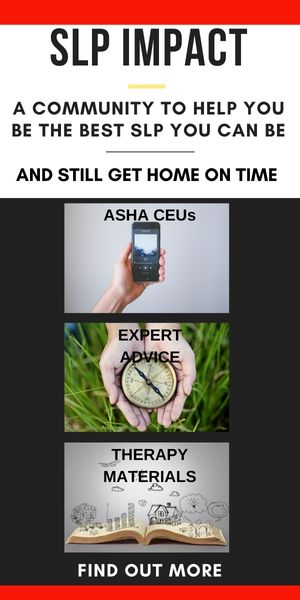
I’ve spent approximately 9,720 hours doing speech-language therapy, and I’ve discovered the secret to a great speech therapy session. Evidence-based practices are essential to our success. However, to me, there is something else that supersedes the research and the academic tenets taught to us in graduate school. What is it? To get to the head (speech and language skills), this SLP needs to go through the heart. Say it with me, “To get to the head, you go through the heart.” So, what does that mean?
The Research
For a long time, I thought I was just emotional—all the time. I cry often, and it is difficult to hide my feelings. Within the last five years, I realized that this has been my SLP Superpower. So, I started to research. With brain science and social health research on my side, I learned that the lovey-dovey stuff, in reality, is essential to our work as speech-language pathologists.
This year has gifted me the work of Dr. Jeffrey Duncan-Andrade. He teaches high school English in East Oakland and is an Associate Professor at San Francisco State University. He believes in providing children with basic needs before they can learn. SLPs, this goes back to our graduate school days and learning about Maslow’s Hierachy. He states, “I’ve always understood intuitively that Maslow was right: I have to start at food, shelter, clothing, safety, and then I have to create a space that gives them a sense of love and belonging…I know you have to win the heart to win the head. But most of my training and the professional development I’d get was about the head. I had to leave the field of education and get into conversations in public health and neuroscience and these other fields to understand from a research perspective what I needed to pay attention to. I knew once kids felt safe, the head would open up for me.”
So, SLPs, repeat his words, “Win the heart to win the head.” Here’s a two-step directive for your speech and language sessions. First, support your students’ and clients’ heart needs. Then, work on speech and language skills. That’s what you need for a great speech therapy session.
3 Tips for Getting to the Heart: SLP Version
- Checking In At the beginning of my sessions, I check in emotionally with my students. During our first session together, I explicitly teach and practice what it looks like to share when Ms. Phuong says, “What’s up?” They know they can share one experience from the day using 3-4 sentences. Then, I use this information to set the tone for a session. One time, I had a student tell me his parents were in the midst of a divorce. So, on that day, the session leaned less on the brain and more on supporting his heart.
- Literacy-based Interventions Dr. Duncan-Andrade talks about how we can get a student to the highest level of Maslow’s hierarchy—the level of self-actualization. To do this, the child needs to feel that he is relevant and valued. Books are a natural (and evidence-based) way to honor backgrounds and life experiences. In our clinic, books reign. We have even written a book on how to use books in speech therapy. Check out Literacy-Based Speech and Language Therapy Activities.
- Know the Child’s Superpower My first session always centers around the child’s favorite things. Is she a Pokémon zealot? Does he love Takis chips? Does he love to draw comic strips? I take this new piece of information, and I bestow the child with this Superpower. Then, I find a way to incorporate it. When what you love is honored, it’s amazing how hard you will work! This is a great way to speak to the heart AND work on his speech and language skills.
Let us champion the whole human being. Here’s to our heart-work, SLPs.




Phuong, I love this! I start my year with the book, In My Heart: A Book About Feelings. Then at the beginning of each session I ask my kids how their hearts are. It’s a great way to connect with them!
Heather! I will have to check out the book. It sounds right up my SLP-alley. I love how you set the tone of your sessions at the beginning of the year. This time is so valuable. You’re right–it’s all about connection. Give my best to your fellow FWISD SLPs!
I enjoyed reading these 3 steps! As a retired Speech Therapist ( worked 40 years in Public School setting w/ Learning disabled & students on the spectrum). This is exactly how I handled my sessions in order to achieve success with my many students
I appreciate your sentiments regarding the value of the heart across various student needs. Most importantly, thank you for the 40 years you gave to your students. You changed lives and empowered many in that time. Here’s to retirement!
I love this post. It is exactly what I needed to hear in the midst of everything. How easy it is to forget about some of the most important things when you are so focused on the racket of goals and deadlines and data points. I want to always underlie my work with the heart. Thank you for the important reminder!
Dearest Wylin! I am so glad this message was so timely. It’s hard to not focus on the deadlines and compliance tasks. They are surely important. The heart, however, is our “why”: why we chose to be in our profession, why are students and clients respond to us, why we keep doing what we do. Keep changing the world, Wylin.
My brother was thinking about enrolling his son in a speech pathology course. He wants to do this so that his son can have a normal life later on. I will let him know that it would help him a lot to have a hobby involved in the sessions to make it interesting or easier.
Alexandria, the best thing about speech-language therapy is that we can incorporate it into all activities. Ideally, working on activities that are 1) of high interest and 2) functional (happens every day naturally) are key. Thank you for taking the time to write us.
It’s great that you elaborated on the positive output of speech therapy sessions. It also helped that I am now aware of what is SLP stands for, Speech-Language Pathologist. I agree that digging the inner character of the child will make a good connection, awesome though!
Joy,
We are always happy to share the (many!) positive outcomes of speech-language therapy. And, like you said, making a connection is at the base of the work we do.
I like how you said that a child needs to feel relevant and valued in order to get them to the highest level of Maslow’s hierarchy. My niece is having speech therapy. I can see if her therapist helps her feel valued and relevant that she will make progress.
Elisabeth, yes! The way in which we support our students, clients and patients yields meaningful outcomes.
I like your idea to check in with the patient at the beginning of the session. My son has a lisp and I want to get him into speech therapy. I’ll look for a therapist who cares about my son and his day.
Skylar,
Finding a complementary match for your son is important. Supporting a child’s emotional needs is important when supporting his overal communication needs.